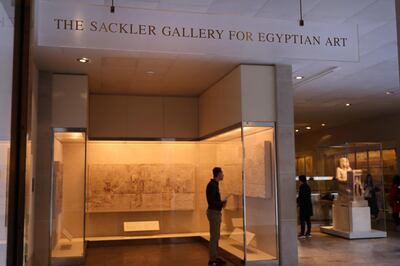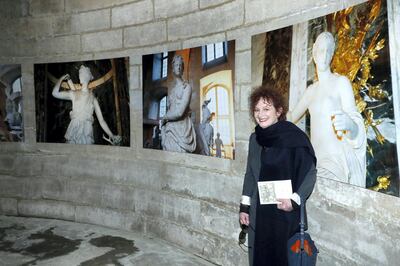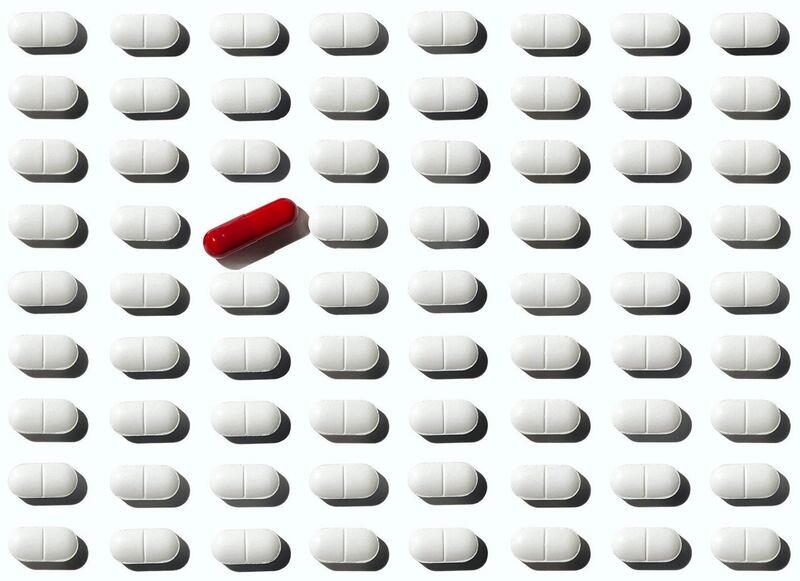Two weeks ago, New York's Metropolitan Museum of Art announced it would no longer accept donations from the Sackler Trust. It's a name synonymous with arts philanthropy; the Sackler family is a transatlantic dynasty famed for making million-dollar donations to museums including the Louvre in Paris, Tate in London and New York's Guggenheim. However, they also own the pharmaceutical giant Purdue Pharma, which since 1996 has manufactured and marketed the highly addictive painkiller, OxyContin. So, as the brand becomes increasingly tied to America's opioid crisis, museums are refusing their money. The story raises questions about the ethics of philanthropic giving: to what extent must museums vet their donors, and should they explore alternative funding models?
Many public museums around the world have been founded on acts of private philanthropy. The Ashmolean Museum in Oxford, New York's Museum of Modern Art and, more recently, Jameel Arts Centre in Dubai, were all established on substantial gifts. It is an essential element of most museums' business strategy, as wealthy patrons are approached and cultivated at private parties, dinners and exclusive events, and, in return, philanthropists fast-track organisations to their fundraising targets. In 2016, Michael Jordan gave $5 million (Dh18.3m) to the National Museum of African American History and Culture; the Art Institute of Chicago received $50 million from trustee Janet Duchossois and her husband, Craig, in 2018; and David Rockefeller's estate donated $200 million to New York's MoMA this year.
Charitable giving is, in many cases, an indispensable lifeline for museums. But it can also be problematic, raising ethical concerns about where the money comes from. The Sackler Trust has generously supported museums for decades, and only now these institutions are cutting ties. But why?
An out-of-control drugs crisis
OxyContin has contributed to an opioid epidemic in America. The US Department of Health and Human Services declared this a public health emergency in 2017. According to figures from the The National Centre for Health Statistics, opioid overdoses accounted for 47,600 deaths that year, more than any previous year on record. Meanwhile, the US Centres for Disease Control and Prevention estimated in 2017 that 4.5 million people have developed an addiction to opioids. The Sacklers stand accused of disguising the addictive dangers of OxyContin in their marketing. Some 1,500 civil cases have been brought against the company and its founders, potentially costing the Sacklers billions of dollars (they're worth an estimated $13 billion).

In response, many museums, which have in the past benefited greatly from Sackler money, have made a very public rebuke, deciding they don't want to be associated with the family's tainted legacy. London's National Portrait Gallery was the first to take a stance, rejecting $1.3 million intended to support a major museum revamp. Two days later, Tate Galleries severed ties with their long-time benefactors, releasing this statement: "The Sackler family has given generously to Tate in the past, as they have to a large number of UK arts institutions. We do not intend to remove references to this historic philanthropy. However, in the present circumstances we do not think it right to seek or accept further donations from the Sacklers." Soon to follow suit were the Metropolitan Museum of Art and Guggenheim in New York, both saying they will no longer accept money from the family.
This story marks a watershed moment for museums, which have benefited from philanthropy since antiquity. We owe the word to the ancient Greeks, whose idea of "philanthropia" translates to "love of humanity". Selflessness is – theoretically – at the core of the act. In Greek cities, wealthy citizens would provide funding for walls, temples and theatrical performances. Philanthropy was intended for the public good. However, with the Sackler case, we have to wonder about the motivations behind this kind of corporate altruism in the modern day. Instead of acting for the good of the people, did the Sacklers use charitable giving to create a smoke screen for their shame? It has also created debate within, and about, the wider museum sector, as to the number of revered cultural institutes benefiting from dubious dollars. When should institutions turn down contributions from undesirable donors?
A history of tainted wealth
Controversial donors are not a new phenomenon. Investment firm manager Jeffrey Gundlach donated $42.5 million to New York's Albright-Knox Art Gallery in 2016. In 2009, he was sued by his former company, TCW, for misappropriating trade secrets. David Geffen, who has given millions to the arts, was caught up in the Hollywood sex abuse scandal; he attended parties thrown by convicted sex offender Marc Collins-Rector. If their money was still accepted by museums, what makes the Sackler case any different?
A high-profile lawsuit, filed in New York on March 18, has accused members of the Sackler family of directly profiting from opioid addiction. They have destroyed the lives of people across America, and made money in the process. The people who have been publicly protesting against the family's involvement behind museum walls were clear: they do not want this blood money in our most treasured public institutions. Now, the reputational risk has become too high for museums and severing ties with the Sacklers has become the solution. They cannot be seen as complicit in this crisis.

Notable photographer and art activist Nan Goldin, who leads a campaign group called Pain – Prescription Addiction Intervention Now – was behind demonstrations held at the Guggenheim and the Metropolitan Museum of Art. She currently has an exhibition up at the Tate; if the museum had not refused Sackler money, Goldin said she would have stirred up chaos. That would have potentially included using thousands of fake torn-up prescriptions for OxyContin like confetti, and showering the space with faux pill bottles, reported The Guardian. "It was going to be creative, it was going to utilise the Sackler escalator that goes right up to the gallery I'm showing in," the artist told the British newspaper.
‘Bound by a duty’
Are museums being held to higher standards than other institutions? It might appear that these institutions' morals are being unfairly scrutinised and raised on a pedestal above other industries. In fact, some would even argue arts organisations should seize the opportunity to turn bad money into public good. Sharon Heal, director of the UK's Museums Association, says museums must make ethical decisions since they "are bound by a duty to the public they serve". In the Sackler case, these are the same people who have suffered at the hands of the pharmaceutical company (Goldin herself revealed she was once dependent on OxyContin).
Yet, just as museums assume a position of trust, donors hold a position of power. The Sackler story also emphasises concerns about motivations for private philanthropy and the legacy it leaves. In the US, donors expect, and often demand, naming rights. You can visit the Sackler Wing of Oriental Antiquities at the Louvre in Paris, the Arthur M Sackler Museum at Harvard University and the Sackler Centre for Arts Education at the Guggenheim. By attaching a donor's name to their wall, the museum endows them with visibility, and ensures a favourable boost to that family's reputation. It also establishes an implicit, shared identity between philanthropist and cultural institution.
Beyond naming rights, donors’ gift agreements will frequently include specific demands, to which the museum will acquiesce. Caveats might include the funding of a particular scholarship or activity, invitations to join a board group or the inclusion of their brand on marketing materials. In 2009, the San Francisco Museum of Modern Art created an agreement to ensure a long-term loan of more than 1,100 works from the collection of philanthropist Donald Fisher. However, the contract demanded that a minimum percentage of Fisher’s pieces were to be displayed at all times. This elicited questions about the diversity of his art collection, and the Fisher Foundation’s curatorial control over museum displays. Some critics felt the integrity of museum had been jeopardised.

In countries such as America and the UK, tax breaks are often another significant benefit to philanthropists, adding to charitable appeal. In the UK, high-earners who pay tax at 40 per cent are eligible to reclaim 25p from the taxman for every £1 donated to charity.
It’s clear there are myriad murky motivations for brands to share their wealth. With money comes power and influence, which ultimately could threaten museums’ public missions to collect, research, preserve and share culture in the service of the public; history itself could be, and probably already has been, altered along the way.
Museums must take steps to properly scrutinise their donors more closely, and earlier on. To do this, they will need to establish an authoritative set of guidelines to ensure ethical philanthropy. Some museums, such as Tate and the Louvre, already have robust policies in place. The Louvre's Ethics Charter on Relations with Individual Donors establishes its prerogative to maintain "independence and integrity". Clearly stated is the museum's "right to refuse any donation or bequest for which there is a doubt as to the legality, source, or origin of the donation or bequest". More particularly, "Musee du Louvre shall act in due care and attention to ensure that accepted donations are not tied to criminal behaviour and, in particular, the misuse of corporate property, fraudulent breaches of trust, embezzlement of corporate funds or corporate assets."
Still, many public arts institutions don't have policies in place. Without established and authoritative guidelines, the public must take it upon themselves to make a judgment – and take a stand. Recently, hundreds of climate change activists protested BP sponsorship of the British Museum. In the age of social media, outrage is platformed online, and impossible for museums to ignore.
Alternative models for funding
How will museums survive if they start turning down corporate sponsorship and Sackler-style donations? Many public-facing arts organisations are already starting to explore alternative, sustainable funding models to philanthropy. For some countries, state funding is still the preference for many museums. Earlier this year, Sheikh Mohammed bin Rashid, Vice President and Ruler of Dubai, directed the launch of the UAE Cultural Development Fund. The Department of Culture and Tourism – Abu Dhabi also pours an abundance of funds and resources into growing and protecting cultural initiatives in the capital, and is responsible for Louvre Abu Dhabi, Guggenheim Abu Dhabi, Zayed National Museum and Al Ain National Museum – to name a few.
The Louvre Abu Dhabi itself represents a new solution. Founded in partnership with 16 prestigious museums in France, including the Centre Pompidou, Musee Rodin and Chateau de Versailles, it paves the way for global cultural collaboration, including international loans. Elsewhere, Scandinavian countries, including Denmark, Norway and Sweden, also state-fund cultural institutions, as they recognise the social benefits of museums, highlighting the long-term advantages of participation in culture for individuals. Of course, these possibilities vary widely from country to country. For comparison, in the UK, public spending cuts have hit museums and cultural organisations hard.

Increasingly, museums are making money through commercial endeavours. As Ellen McAdam, director of Birmingham Museums Trust, explains: "Over seven years we have grown our income from traditional commercial activities such as admissions, catering, venue hire and retail to form 60 per cent of our turnover".
University partnership-working is another option. Universities increasingly need to share their research externally, and are seeking collaborations with museums for joint projects, exhibitions and funding bids. In the UAE, Sharjah Museums has partnered with the University of Sharjah, putting a focus on cultural education, exhibitions and research.
Although museums are starting to explore new models, they also can’t afford to exclude private philanthropy altogether. Yet, in light of the Sackler scandal, there will be two major changes. Firstly, the public will be more outspoken, demanding more transparency than just a donor’s name emblazoned on the wall. Secondly, museums will effect more rigorous vetting procedures. Any financial gift must ultimately serve the museum, rather than the donor’s desire to build their brand.





